What is Growth Hacking and its process

It’s also the buzzword in Silicon Valley. Well, actually, it’s the buzzword among startups seeking accelerated growth. It represents a new approach to Digital Marketing. It encompasses everything you do for the growth of your company.
Growth Hacking is what has turned startups into multi-billion-dollar companies like Dropbox, Evernote, Facebook, and Google, among many others. Everyone wants a Growth Hacker, and the reason is obvious. They achieve ridiculous amounts of growth in a short time.
Look at Facebook Growth
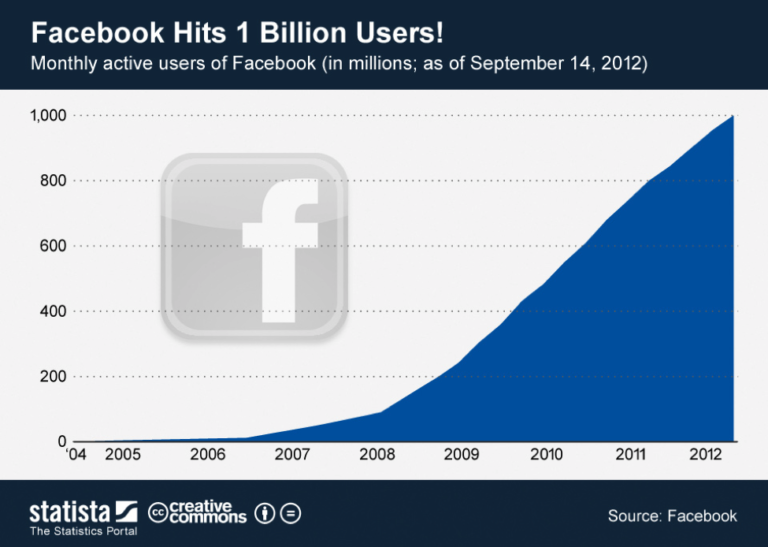
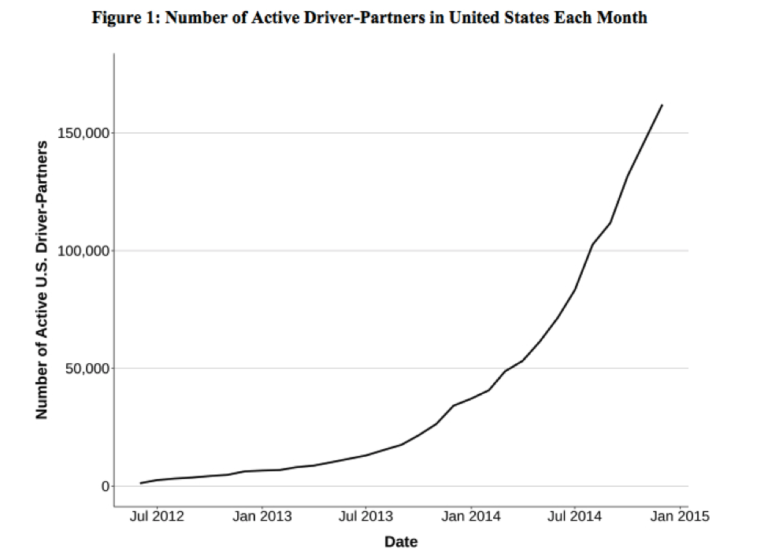
Growth Hacking has been around for years, but it’s only recently that the term has gained momentum.
Ever since programmers and developers started creating software, they’ve sought ways to spread the word about their products, developing all sorts of creative ideas to make their products known.
¿What is Growth Hacking?
The term is just 10 years old. It was first used by Sean Ellis in 2010 when he was trying to define a job description.
Sean Ellis is the original Growth Hacker. He is responsible for the accelerated growth of Dropbox. In other words, we all know and use Dropbox thanks to his consulting work.
Every time Sean worked with a company, finding his replacement was challenging. Marketing people couldn’t do Sean’s job because they always focus on budgets, reports, branding, and other things.
A growth hacker has only one goal: growth. It’s their only metric.
If a startup, or any small company in general, doesn’t quickly grow its customer base, it heads towards bankruptcy. An engineer can be as good a Growth Hacker as any marketing person.
In growth hacking, the most important aspects are creative thinking and clear objectives.
Due to the digital ecosystem, a Growth Hacker combines skills and knowledge in analytics, web design, user experience, and marketing, all with the sole purpose of growing the customer base.
That’s the job of a Growth Hacker!
What is the Growth Hacking Process
The first thing you need to do is ensure you build a product that people want to buy.
This is a concept known as Product/Market fit.
It means you should create a product that captivates your customers, solves their problems, and makes their lives easier.
In the past, companies could make whatever type of product they wanted and, with enough advertising, they could get the public to buy it. This is no longer possible. Traditional marketing doesn’t work now.
You wouldn’t buy a mediocre product or one that doesn’t satisfy your desires, ¿would you? Well, your customers wouldn’t either.
Before any growth hacking
1. Product Market Fit
This is fundamental. You need to understand your customer and your market. It doesn’t matter if you sell products or services. The first step to having any business is knowing your customer.
Consider the desires and needs of your customer, then reflect on your product. Does your product truly meet their needs in terms of price, purchase accessibility, quality, expectations, perceived value, among other characteristics?
Are you sure that the attributes you offer in your products create value for the customer?
You should ask yourself the following questions about the customer, the market, and the competition.
- Questions About the Customer
- Who are your current and potential customers?
- How many are they?
- What are the characteristics of the different groups?
- What are their buying and consumption habits?
To answer the above questions, you can conduct exercises and workshops on user archetypes and market studies.
You can conduct interviews, research secondary sources, or use various traditional marketing research methods.
Here you can learn more about customer archetypes.
- Questions About the Competition
- Who are your competitors?
- What types of products do they offer?
- At what price?
- What is your competitors’ strategy? Price, quality, other?
This information can be easily purchased from Chambers of Commerce and similar associations.
You can also search on Google for the product category or service you need and review the search results.
Information about the competition is relatively easy to find, or if you can’t find it, you can use the oldest trick in the book…
Call and pretend to be a potential customer to receive all the information you’re interested in.
- Questions About the Market Itself
- Who makes up the market: consumers, businesses, at the local, national, international level?
- Is the market growing or shrinking?
- Is there seasonality in the market?
- Is the market well-developed, or are new products entering?
- Is the market volatile?
- Is it likely that new technology will change the market?
- What kind of changes can affect demand?
Now, it’s not enough to just ask yourself and reflect internally. You must conduct thorough research, write it in documents, take screenshots, make comparative Excel tables, and use tools that allow you to visualize and analyze the information to ultimately draw well-informed conclusions and recommendations.
If you don’t want to do a complete market study, at least remember these two things.
Ask many questions before proposing any solution. You can conduct surveys, pay for ads and analyze your CTR, or even use social networks.
As soon as you have an idea, start seeking people’s opinions. Get feedback from your potential buyers before you start developing a product.
Don’t fall in love with your ideas. Remember that customers pay because you solve their needs, not because they like the features and specifications of your product.
¿Why is it important to conduct surveys and ask the opinion of potential customers?
Look at the growth of Instagram.
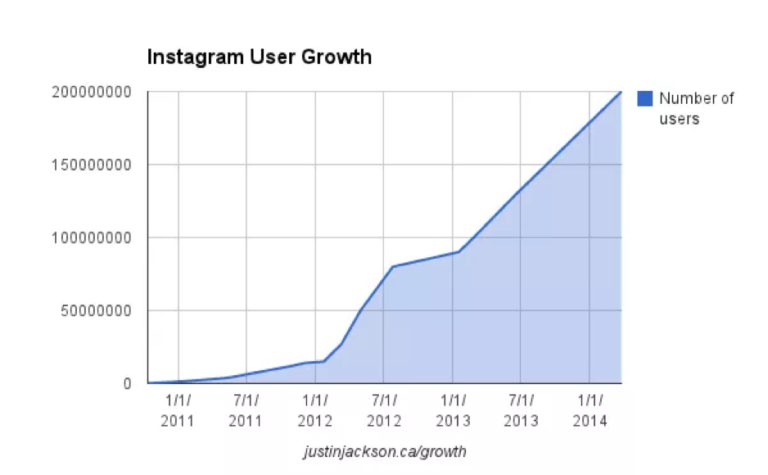
Did you know that Instagram was initially called Burbn? It was an app for Whiskey enthusiasts. They realized that the most used feature of the app was its photo-sharing mechanism.
It was a wise decision not to fall in love with their product and to develop what customers were asking for, rather than trying to force the use of a mediocre product. This is something you should do continuously.
Even if you have a product that sells, don’t forget to constantly improve it and look for new ways to satisfy your customers. Once you achieve a good product – one that people want to use, a product that captivates your customers… A good product/market fit, then it’s time to grow it.
2. Define Success Metrics or KPIs
It’s always important to track and measure all marketing actions.
KPIs are indicators of how the business is doing in achieving strategic objectives. Initially, focus on one at a time. The most important ones are:
- Customer Acquisition Cost: CAC
CAC is what it costs to acquire a new user. A user is someone who uses your product, whether for free or by paying.
It’s calculated as the total expenditure for acquiring a customer (PPC, content marketing, social media…) in a given month, divided by the total number of new customers acquired or activated in that month.
- Lifetime Value: LTV
This is the total monetary benefit that an average customer brings to the business.
It’s calculated as the total revenues a customer generates for your company (average revenue per customer from the moment they sign up until their last purchase), minus the customer acquisition cost.
- Viral Coefficient: K
Some call it the amplification factor. It’s the average growth through referrals.
It’s calculated as the number of sign-ups through customer invitations, divided by the number of invitations sent by those customers.
- Churn Rate
This indicates how many visitors abandon the conversion funnel. You always want to reduce this percentage and retain more customers. Focus on reducing this metric to achieve rapid growth.
The Growth Hacking Funnel
Generally, marketing objectives fall into one of these five categories.
.
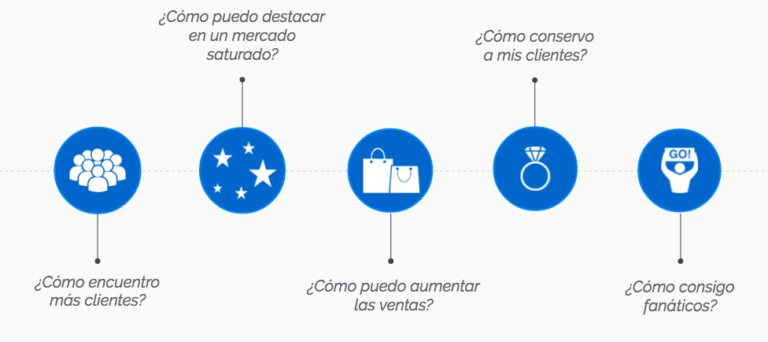
The Growth Hacking funnel aims to address all the needs of a company’s marketing objectives using creative user attraction techniques to turn them into loyal and happy customers.
This funnel illustrates the journey users go through when making a purchase, while also acknowledging that it’s normal to lose some users along the way.
It consists of five steps.
Some call it the “Pirate” technique, due to its acronym in English, AARRR (say it with a pirate accent). Acquisition, Activation, Retention, Revenue, and Referral.
This is the process we use with all our clients in their digital marketing strategies, as we originally started as a Growth Hacking agency.
Now you understand what Growth Hacking is.
1. Acquisition
After conducting the relevant market studies and having defined your objectives (KPIs), you can then implement Growth Hacking techniques.
The first step is to acquire potential customers, and for this, it’s necessary to bring people to your business.
You need to get noticed, to catch the clients’ eyes. It’s like when you like someone and you wear your best dress to be seen… It’s just like that.
In this stage, the goal is specifically to acquire traffic.
Most people believe this is the crucial stage of the funnel (it’s not). It’s the first and most expensive one. Without it, the other stages can’t happen, but we’ll see later which part is the most important.
The most commonly used techniques for attraction are SEO and SEM.
Below is a screenshot of the search “buy shoes”, where you can see the ads at the top and then the organic results.
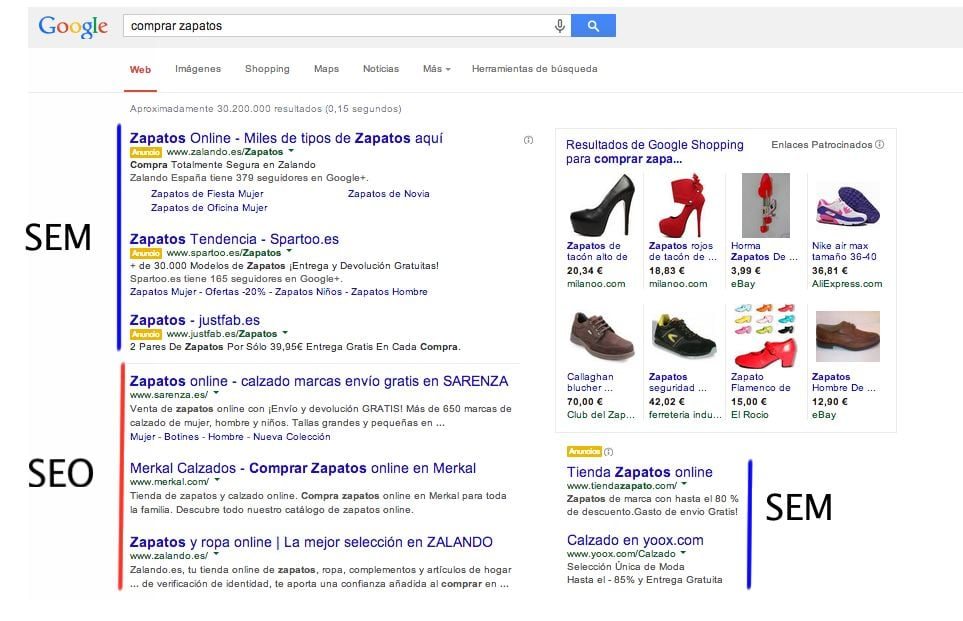
Note: Google is constantly changing how it displays ads, so it may look different at the time you read this article.
Of the $75 billion dollars that Google earned in 2015, $67.4 billion came from its two advertising programs: $52.4 billion from AdWords and $15 billion from AdSense.
Only $7.2 billion dollars came from its other businesses. So, it’s not hard to imagine that most companies allocate about 80% of their digital budget to driving traffic to their site, generally through advertising.
2. Activation
People have now seen your business, products, or services, but this is not enough because you likely have competition, and customers don’t know who to buy from since all options seem similar.
In this stage, we need to spark the customers’ interest and try to capture their data to deepen the commercial relationship.
You should try to obtain customer data for personalized and direct communication.
The idea is to capture their details like name, email, WhatsApp number, try to engage through inbox messages on social networks, or their telephone number.
It’s similar to when you meet someone you like and need their details to continue cultivating a relationship. In marketing, you’ll want to capture the details of your visitors since it’s possible that someone who doesn’t buy from you today might purchase in the future.
It’s your job to stay in touch with them until they make a purchase.
At Dazzet, at one point, we asked for visitors’ details in exchange for a free course.
With this technique, we acquired our first customers.

It’s crucial to initiate a relationship with potential customers because even though they may be familiar with the products or services, they might not yet be ready to do business with the brand.
3. Retention
This is the most important phase of the growth hacking funnel. Here, the magic happens, or all efforts are lost.
It’s like when you meet someone you like and want to win over. That’s how it should be with your potential customers.
You won’t go to the movies or dinner with them, but…
You will show them that you are the best option for them. You will provide content and generate value in advance, making them fall for you even before you try to sell them anything.
If you do a great job of enchanting your customers with valuable content, they will want to buy from you even before you present the initial offer, and likely, price will never be a deciding factor.
In marketing, the explanation is simple.
The longer a person spends browsing your website, the more contact they have with the brand, exponentially increasing the chances of purchase and future visits.
Optimove explains this quite well.

This is the most crucial part of the funnel, as it’s at this stage that we can lose all the efforts and expenses of the previous stages.
We need to think as if we are trying to win someone over. Be attentive, timely, relevant, and at the same time avoid being too aggressive in selling.
The key is continuous optimization, always seeking a better product and service. The goal is to constantly charm the customers.
Don’t forget the concept of Product/Market fit.
4. Monetization
You’ve shown your potential customer your products and services, generated value in advance, and demonstrated that you’re the best option.
So, you’ve done everything within your power to meet the customer’s needs.
Now, it’s your duty to yourself, your partners, and your organization to make direct offers so that the customer buys your products.
But monetizing is much more than just showing a price.
It’s not easy to bring users to this point; it requires special attention, as all the marketing effort can be lost at this critical juncture.
We say that acquisition is the most expensive, retention is the most important in the funnel. But monetization is the goal of any business.
Without sales, there’s nothing.

This transaction can occur online or in a physical store, depending on the type of customer, product or service. It doesn’t matter, the goal is to obtain monetary results.
5. Virality or Referral
Virality or referral is a growth hacking strategy that encourages existing customers to refer new customers. This can be a very effective way to acquire new customers, as it is essentially free marketing.
Dropbox is a famous example of a company that used virality to grow its business. The company’s referral program offered users free storage space if they referred their friends. This program was a huge success, and it helped Dropbox to grow its user base by 3900% in just 15 months.

- “Why Implement a Referral Program?
After securing the first sale, there’s a sense of joy and accomplishment.
However, as previously discussed, there’s a concept known as ‘customer acquisition cost’. This implies that generating sales incurs expenses for a company. Costs include advertising, sales personnel salaries, staff wages, rental expenses, utilities, etc. The most efficient and cost-effective method to generate new sales is through our existing customers.
We should aim to offer them additional products that meet their needs.
We can either increase the frequency of their purchases or re-purchases (encouraging them to buy more often), or we can implement loyalty and referral programs. These programs assist in turning our customers into advocates who bring in new clients.
Since there’s no investment in advertising at this stage, the acquisition cost for new customers significantly reduces due to these testimonials.
It’s crucial to remember that no customer will recommend a mediocre product or repurchase from a company where they had a bad shopping experience. In theory, this is the final step in Growth Hacking, but it’s important to remember that it’s a continuous improvement process. It’s an infinite loop that needs to be repeated endlessly.
That’s why I add a final step in the growth hacking funnel.
Rinse and repeat.
No company engages in marketing just once. The same goes for digital marketing and specifically for growth hacking. No one does growth hacking just once.
If an experiment works well, repeat it and increase the budget. If it fails, then move on to the next one.
You either win or learn. There’s no losing or stopping. If a brand aims to achieve specific digital marketing goals in a campaign, it undoubtedly needs to devise a tailored strategy. This strategy should cater to their needs and budget, stimulating interaction with users to spark conversations and engage them in a long-term relationship, eventually turning them into profitable customers.
Now it’s your turn.
Have you ever applied any business growth hacks?
I’m sure you know a few that you can share. If not, I also invite you to share your thoughts about Growth Hacking and whether you think it can be applied in your company.”
Juan Esteban Yepes
